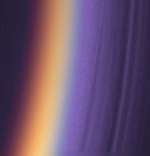Scientist explain methane in Titan's atmosphere
Posted: Thu, Mar 2, 2006, 8:09 AM ET (1309 GMT)
 The methane detected in Titan's dense atmosphere was generated by three distinct outgassing episodes, scientists have concluded. In a paper published in the March 2 issue of the journal Nature, a group of planetary scientists in Arizona and France described their model to explain why Titan's atmosphere contains methane, a gas that breaks down in sunlight after tens of millions of years and thus must be continually replenished. Their models indicates there have been three times in the moon's history when the planet has released methane into the atmosphere: in the first billion years after its formation; two billion years ago, when its silicate core began to convect; and again starting 500 million years ago, when its icy crust began to convect and cool. This last episode, which is still in progress, will end in a few hundred million years, with no further episodes of methane outgassing before the sun enters its red giant phase and heats up the moon.
The methane detected in Titan's dense atmosphere was generated by three distinct outgassing episodes, scientists have concluded. In a paper published in the March 2 issue of the journal Nature, a group of planetary scientists in Arizona and France described their model to explain why Titan's atmosphere contains methane, a gas that breaks down in sunlight after tens of millions of years and thus must be continually replenished. Their models indicates there have been three times in the moon's history when the planet has released methane into the atmosphere: in the first billion years after its formation; two billion years ago, when its silicate core began to convect; and again starting 500 million years ago, when its icy crust began to convect and cool. This last episode, which is still in progress, will end in a few hundred million years, with no further episodes of methane outgassing before the sun enters its red giant phase and heats up the moon.
 The methane detected in Titan's dense atmosphere was generated by three distinct outgassing episodes, scientists have concluded. In a paper published in the March 2 issue of the journal Nature, a group of planetary scientists in Arizona and France described their model to explain why Titan's atmosphere contains methane, a gas that breaks down in sunlight after tens of millions of years and thus must be continually replenished. Their models indicates there have been three times in the moon's history when the planet has released methane into the atmosphere: in the first billion years after its formation; two billion years ago, when its silicate core began to convect; and again starting 500 million years ago, when its icy crust began to convect and cool. This last episode, which is still in progress, will end in a few hundred million years, with no further episodes of methane outgassing before the sun enters its red giant phase and heats up the moon.
The methane detected in Titan's dense atmosphere was generated by three distinct outgassing episodes, scientists have concluded. In a paper published in the March 2 issue of the journal Nature, a group of planetary scientists in Arizona and France described their model to explain why Titan's atmosphere contains methane, a gas that breaks down in sunlight after tens of millions of years and thus must be continually replenished. Their models indicates there have been three times in the moon's history when the planet has released methane into the atmosphere: in the first billion years after its formation; two billion years ago, when its silicate core began to convect; and again starting 500 million years ago, when its icy crust began to convect and cool. This last episode, which is still in progress, will end in a few hundred million years, with no further episodes of methane outgassing before the sun enters its red giant phase and heats up the moon.
Related Links:
| <<previous article | next article>> |
|
news in brief
|
|
China launches first Long March 12A, but booster landing fails
Posted: Sun, Dec 28 9:50 AM ET (1450 GMT) |
|
news links
|
|
Tuesday, December 30
Amanda Nguyen Experienced Depression After Backlash from Blue Origin Flight: 'I Felt Like Collateral Damage'
People — 3:44 am ET (0844 GMT) How will the SpaceX IPO affect MDA Space?
Cantech Letter — 3:44 am ET (0844 GMT) Red tape could ‘jeopardise’ Shetland space launch plans, expert warns
Press Association — 3:41 am ET (0841 GMT) How the moon kicked Chandrayaan-3 propulsion module into a new orbit
The Hindu — 3:41 am ET (0841 GMT) With only 5 launches in 2025. What’s behind ISRO’s project delays
ThePrint (India) — 3:40 am ET (0840 GMT) |